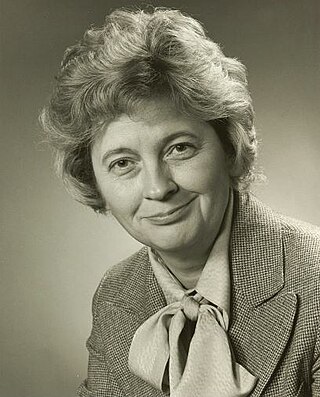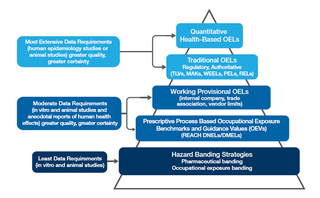
In organic chemistry, isocyanate is the functional group with the formula R−N=C=O. Organic compounds that contain an isocyanate group are referred to as isocyanates. An organic compound with two isocyanate groups is known as a diisocyanate. Diisocyanates are manufactured for the production of polyurethanes, a class of polymers.

The American Conference of Governmental Industrial Hygienists (ACGIH) is a professional association of industrial hygienists and practitioners of related professions, with headquarters in Cincinnati, Ohio. One of its goals is to advance worker protection by providing timely, objective, scientific information to occupational and environmental health professionals.

The National Institute for Occupational Safety and Health is the United States federal agency responsible for conducting research and making recommendations for the prevention of work-related injury and illness. NIOSH is part of the Centers for Disease Control and Prevention (CDC) within the U.S. Department of Health and Human Services. Despite its name, it is not part of either the National Institutes of Health nor OSHA. Its current director is John Howard.

Occupational hygiene is the anticipation, recognition, evaluation, control, and confirmation (ARECC) of protection from risks associated with exposures to hazards in, or arising from, the workplace that may result in injury, illness, impairment, or affect the well-being of workers and members of the community. These hazards or stressors are typically divided into the categories biological, chemical, physical, ergonomic and psychosocial. The risk of a health effect from a given stressor is a function of the hazard multiplied by the exposure to the individual or group. For chemicals, the hazard can be understood by the dose response profile most often based on toxicological studies or models. Occupational hygienists work closely with toxicologists for understanding chemical hazards, physicists for physical hazards, and physicians and microbiologists for biological hazards. Environmental and occupational hygienists are considered experts in exposure science and exposure risk management. Depending on an individual's type of job, a hygienist will apply their exposure science expertise for the protection of workers, consumers and/or communities.
The threshold limit value (TLV) is a level of occupational exposure to a hazardous substance where it is believed that nearly all healthy workers can repeatedly experience at or below this level of exposure without adverse effects. Strictly speaking, TLV is a reserved term of the American Conference of Governmental Industrial Hygienists (ACGIH), who determines and publishes TLVs annually. TLVs issued by the ACGIH are the most widely accepted occupational exposure limits both in the United States and most other countries. However, it is sometimes loosely used to refer to other similar concepts used in occupational health and toxicology, such as acceptable daily intake (ADI) and tolerable daily intake (TDI). Concepts such as TLV, ADI, and TDI can be compared to the no-observed-adverse-effect level (NOAEL) in animal testing, but whereas a NOAEL can be established experimentally during a short period, TLV, ADI, and TDI apply to human beings over a lifetime and thus are harder to test empirically and are usually set at lower levels. TLVs, along with biological exposure indices (BEIs), are published annually by the ACGIH.

Eula Bingham was an American scientist, best known as an Assistant Secretary of Labor for Occupational Safety and Health (OSHA) during the Presidency of Jimmy Carter. During her tenure as the head of OSHA, she eliminated more than 1,000 pedantic regulations and shifted the agency's focus to health and safety risks, establishing strict standards for workers' rights to know about their exposure to hazardous substances.
Occupational and Environmental Medicine (OEM), previously called industrial medicine, is a board certified medical specialty under the American Board of Preventative Medicine that specializes in the prevention and treatment of work-related illnesses and injuries.
The American Society of Safety Professionals (ASSP), formerly known as American Society of Safety Engineers (ASSE), is a global organization of occupational safety and health (OSH) professional members who manage, supervise, research and consult on work-related OSH concerns across all industries. Society members use risk-based approaches to prevent workplace fatalities, injuries and illnesses.
An occupational exposure limit is an upper limit on the acceptable concentration of a hazardous substance in workplace air for a particular material or class of materials. It is typically set by competent national authorities and enforced by legislation to protect occupational safety and health. It is an important tool in risk assessment and in the management of activities involving handling of dangerous substances. There are many dangerous substances for which there are no formal occupational exposure limits. In these cases, hazard banding or control banding strategies can be used to ensure safe handling.

David Michaels is an American epidemiologist and professor in the Departments of Environmental and Occupational Health and Epidemiology at the Milken Institute School of Public Health of the George Washington University. He held high-level, senate-confirmed public health positions in the administrations of Presidents Barack Obama and Bill Clinton, including a stint from 2009 to 2017 as the administrator of the Occupational Safety and Health Administration.
A short-term exposure limit (STEL) is the acceptable average exposure over a short period of time, usually 15 minutes as long as the time-weighted average is not exceeded.
Anna Medora Baetjer was an American physiologist and toxicologist, known for her research into the health effects of industrial work on women and for her discovery of the carcinogenic properties of chromium.
Engineering controls are strategies designed to protect workers from hazardous conditions by placing a barrier between the worker and the hazard or by removing a hazardous substance through air ventilation. Engineering controls involve a physical change to the workplace itself, rather than relying on workers' behavior or requiring workers to wear protective clothing.

Occupational dust exposure occurs when small particles are generated at the workplace through the disturbance/agitation of rock/mineral, dry grain, timber, fiber, or other material. When these small particles become suspended in the air, they can pose a risk to the health of those who breath in the contaminated air.

The Mount Sinai Selikoff Centers for Occupational Health are a set of occupational and environmental health clinics that focus on the prevention, diagnosis, and treatment of workplace injuries and illnesses. Significant injuries and illnesses that are treated at the clinical centers include occupational lung cancers, manganese/silica/lead exposures, and asbestos-related illness, which was the career-long research of Dr. Irving Selikoff, the centers' inaugural director. The Selikoff Centers for Occupational Health's multidisciplinary health care team includes physicians, nurse practitioners, industrial hygienists, ergonomists, social workers, and benefits specialists, who are "leaders in the prevention, diagnosis and treatment of workplace injuries and illnesses," and provide comprehensive patient-centered services in New York City and Lower Hudson Valley. The clinical centers are located within the Icahn School of Medicine at Mount Sinai under the Division of Occupational and Environmental Medicine.

Occupational exposure banding, also known as hazard banding, is a process intended to quickly and accurately assign chemicals into specific categories (bands), each corresponding to a range of exposure concentrations designed to protect worker health. These bands are assigned based on a chemical’s toxicological potency and the adverse health effects associated with exposure to the chemical. The output of this process is an occupational exposure band (OEB). Occupational exposure banding has been used by the pharmaceutical sector and by some major chemical companies over the past several decades to establish exposure control limits or ranges for new or existing chemicals that do not have formal OELs. Furthermore, occupational exposure banding has become an important component of the Hierarchy of Occupational Exposure Limits (OELs).
The Journal of Occupational and Environmental Hygiene is a monthly peer-reviewed journal covering occupational and environmental medicine, especially in regards to hygiene. It was established in 2004 by the merger of Applied Occupational and Environmental Hygiene and AIHA Journal. It is published by Taylor & Francis along with the American Industrial Hygiene Association and the American Conference of Governmental Industrial Hygienists, of which it is the official journal. The editor-in-chief is Michael D. Larrañaga. According to the Journal Citation Reports, the journal has a 2017 impact factor of 1.462.

The Division of Industrial Hygiene was a division of the U.S. Public Health Service (PHS) with responsibility for occupational safety and health programs. It existed from 1914 until 1971, when it became the National Institute for Occupational Safety and Health (NIOSH). It had several names during its existence, most notably the Office of Industrial Hygiene and Sanitation in its earlier years and the Division of Occupational Health during its later years.
The Bureau of Labor Standards was an agency of the U.S. Department of Labor from 1934 until 1971. It was the direct predecessor of the Occupational Safety and Health Administration. The unit was formed as the Division of Labor Standards in November 1934, and renamed the Bureau of Labor Standards in 1948.

Shawn G. Gibbs is an American industrial hygienist. As of 2020, he is the dean of the Texas A&M University School of Public Health. His research focuses on the disruption of high consequence infectious diseases.










